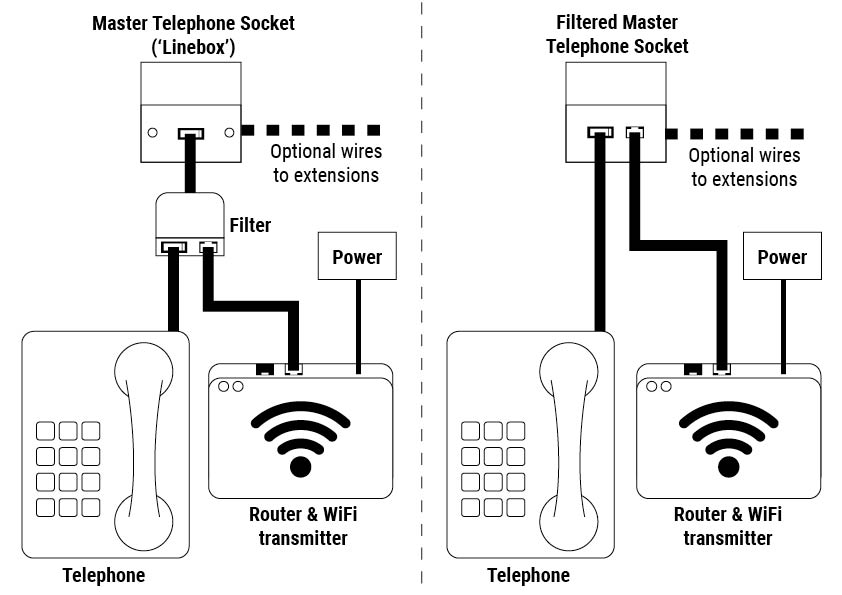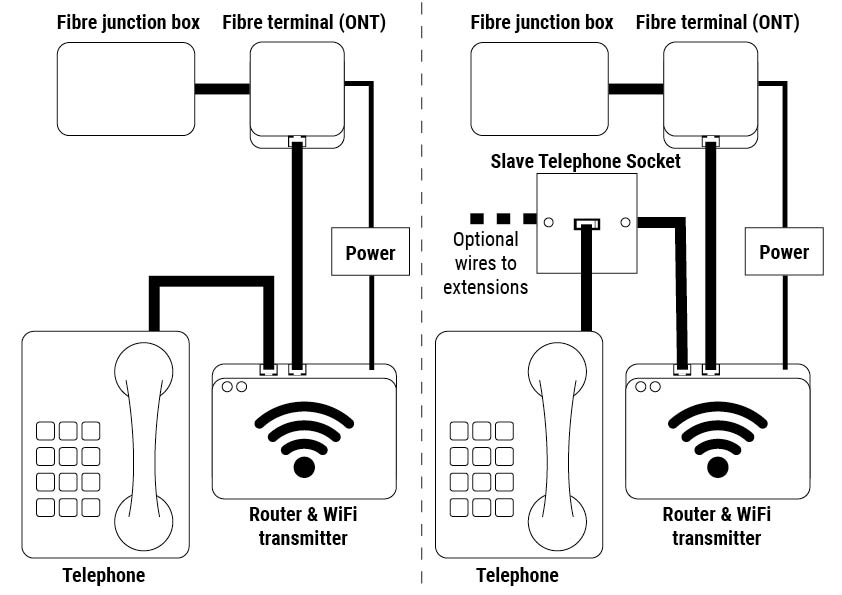The way that homes and businesses are connected to the telecoms network is changing. Direct links over copper wires between the telephone exchange and your premises are being phased out in favour of fibre optic links for all or part of the connection. Whilst this should bring faster Internet services, it may also bring problems for people who still rely on a landline telephone, particularly in the parts of the parish where mobile telephone signal is poor.
Probably no later than the start of 2027, you will no longer get a dialling tone at the master telephone socket in your house. More...
Most people will be asked to plug their phone into their broadband router instead of the master telephone socket. But be careful to check that any new broadband contract, even with your existing supplier, still includes a phone service if you need it, as some suppliers no longer offer phone services at all. More...
If you rely on your landline, you ought to get a battery back-up for your router, which your supplier should be able to supply if you explain your need. More...
If you have a care alarm, medical monitor, burglar alarm or other alarm system connected to your phone line, it may not work on a digital service. Your telephone supplier should not force you to switch to a digital service until this is resolved with the alarm company. More...
If you have a traditional phone line only, and no broadband or Internet connection, you won't be forced to get a computer or smartphone: you will be offered a replacement phone service at roughly the same cost as now. More...
Most phones will work with digital phone services: your supplier may try to sell you new phones but they are normally not required. The only exception may be old phones with no * and # buttons, and even they can be made to work with an extra adapter. More...
Extension phone sockets and additional bells can be made to work with digital phone services, but they won't work automatically: they need to be adapted. More...
Your supplier may not tell you about it, but there is a back-up plan for people who can't switch to digital phone services: it works just like a traditional phone line, including during power cuts, and it's called 'SOTAP for Analogue'. More...
If in doubt, ask them! More...
It is important to note that true fibre FTTP connections no longer come with a traditional phone line. If you switch to full-fibre broadband, you will need to move your phone number to a digital phone service that runs over your broadband connection: and all telephone connections will be changed to this new system by 2030 at the latest, with most switched by 2027.
BT no longer manage the telephone network directly: the separate Openreach business manages the telephone exchanges, poles and wires that make up the old BT (formerly General Post Office) network, whilst new providers either share the Openreach network with BT or have built their own networks.
Openreach intend to withdraw the traditional telephone service by January 2027 (delayed from January 2025), and true fibre FTTP connections no longer come with a traditional phone line.

The traditional way to connect your phone to the exchange is by plugging it into a 'master' socket or 'linebox'. Your broadband router, if you have one, plugs into the same socket via a filter, or a second socket on the master socket.
When the traditional phone service is discontinued (or when you voluntarily move to a digital phone service) the 'PSTN' equipment at the telephone exchange that provides the dialling tone, connects your calls and makes your phone ring will be switched off, and the telephone socket in your home will stop working.
This ‘PSTN’ system will be replaced by digital phone services that work over your broadband connection. If you don’t change your phone system, you will eventually lose your telephone service.
Some providers – notably PlusNet – no longer offer a telephone service at all on new fibre broadband contracts, so check your contract carefully if you switch to full fibre broadband or accept an offer to take up a new contract.
If you switch to full-fibre broadband, you will now need to move your phone number to a digital phone service: BT call it “Digital Voice”, Wildanet call it “Phoneline+”, other providers may call it anything they like, but it’s VOBB or VOIP (Voice Over BroadBand or Voice Over Internet Protocol).
Whatever it’s called, it relies on you plugging your telephone into the back of your broadband router (or a separate adapter) rather than into the telephone socket on the wall. If you have internal wiring to extra extension phone sockets, extension bells, alarms etc, this will need to be adapted to connect to the socket on your router/adapter instead of the ‘master socket’.

If you want your digital landline to work in a power cut, you will need to install a back-up battery for your Internet connection. Traditional phone lines are powered from the telephone exchange, which has both batteries and a generator to keep lines working for days in case of a power cut: digital phones are not connected to this power supply, and will not work if the power fails.
Even a momentary power cut can cause your router to take several minutes to restart, during which time you won't be able to use your phone.
If you live in a property where you rely on your landline, e.g. where there is no mobile phone signal, your phone provider is obliged to provide a back-up battery that will last at least an hour.
You can also provide your own back-up by purchasing a ‘UPS’ (Uninteruptible Power Supply) to power your broadband router and, if you have one, fibre connection box (ONT).
Not all care alarms are compatible with digital phone services. Before switching phone service, tell your phone provider and care alarm supplier to make sure that you won’t lose your service. At the moment, Ofcom have ruled that suppliers must check that your care alarm will still work before you are switched to a digital phone line if you have a care alarm.
The government back up this policy, and have set up a Telecare National Action Plan to monitor it.
Telephones with a rotary dial, or which don’t have * and # buttons, may need a pulse-to-tone adapter to work with digital phone services.
Because your telephone service will no longer arrive at the ‘master’ socket, extension, bell or alarm wiring from the master socket won’t work unless it is rewired to be connected to the telephone socket on your router instead. It's relatively easy to adapt the wiring, and kits are available on-line.
BT/EE also offer wireless adapters for extension telephones.
If you don't have a broadband service at the moment and just have a telephone-only phone line, then you will be offered a replacement service at a similar cost. It may be a dedicated broadband service that only runs a replacement phone service, or it may be 'SOTAP for Analogue' (see below). You do not need to get a computer or smartphone to continue to use a telephone at home.
You can also ‘port’ your telephone number to a separate VOIP provider and detach your phone number from your broadband service – but beware that doing so can cause your broadband service to be terminated. Having a separate VOIP service can have advantages, such as enabling you to make and receive ‘landline’ calls on a smartphone, for example. You can buy ‘IP’ telephones that connect to VOIP, or VOIP ‘Analogue Telephone Adapters’ to connect almost any traditional telephone to VOIP (some even work with rotary dial telephones!).
Openreach have a little-known ‘backup’ solution for people who, for some technical reason, cannot be moved on to a digital phone line. This is known as a 'Pre-Digital Phone Line' (PDPL) or SOTAP for Analogue and effectively means that the digital conversion will happen at the exchange, with a telephone service supplied via copper wires to your master telephone socket. It will effectively be just like the traditional service, and will work in a power cut. This is expected to last only until 2030. It will only be for existing customers, not new lines, and only for customers who do not have broadband.
Here is a link to the latest information about the provision of fibre broadband to the area.
Here is a link to Ofcom’s advice about the switch to digital phone services.
From https://www.ofcom.org.uk/phones-and-broadband/landline-phones/future-of-landline-calls/